🕒 Article read time: 2 minutes
The new business imperative: achieving supply chain velocity
By Michael Cucchi
Content sponsored by PROJECT44

Today your ability to serve your customer, outpace competition and control costs is dependent on and differentiated by your supply chain maturity. But in today’s never-normal, supply chains are plagued with friction. External friction from extreme climate events, labour challenges and political conflict, exacerbated by internal friction from siloed data, rigid platform design and overreliance on error-prone manual processes.
Overcoming these many sources of friction and thriving in today’s global economy requires a high-velocity supply chain. One with complete visibility from source to customer doorstep, streamlined facility automation, and timely collaboration with carriers, customers, suppliers and partners. A high-velocity supply chain enables you to reduce logistics costs, retain and expand your customer base, and optimise operations, turning your supply chain from a business risk to a critical differentiator.
We’ve long heard from our customers the importance of supply chain modernisation to overcome friction, so it was no surprise that a recent IDC white paper,* sponsored by project44, revealed this to be an executive-level priority. Those surveyed called out new technology investments and new approaches to deliver visibility, control and predictability. As they do, a next generation supply chain is being defined. One that injects new agility and velocity to drive cost savings, customer experience and business differentiation.
“Velocity” in supply chain refers to accelerating the flow of operations, minimising bottlenecks, reducing human toil, improving data quality and removing logistics delays. To achieve this, state-of-the-art capabilities such as end-to-end visibility, process automation, machine learning and real-time analytics allow businesses not only to respond swiftly, but to anticipate and pre-emptively address potential challenges. The shift is transformative, pivoting businesses from reactive entities to predictive powerhouses.
The new IDC white paper, sponsored by project44, sheds light on the pivotal role of velocity in supply chains, including the following insights:
-
Efficiency as a cornerstone: Across the globe, supply chains are zeroing in on waste reduction and heightened efficiency. More than half of respondents across all regions identified “optimise the supply chain to reduce costs” as a top priority for their department in the next 12 months. Better visibility was identified as a key capability to drive efficiency and decrease costs, because you can’t fix what you can’t see.
-
The imperative of collaboration: While there's widespread acknowledgment about the value of collaboration and visibility among supply chain entities, the actual implementation lags. The white paper found that over 50% of companies understand that sharing data in a structured digital format bolsters supply chain performance. Yet, the current reality is that less than half of all logistics-related information benefits from this digital approach.
-
The high cost of operational blind spots: The ramifications of limited visibility are glaring. An alarming 32% of businesses have found themselves overpaying for logistics. Additionally, 30% have grappled with lost sales or dwindling revenues, and an equivalent percentage has faced challenges in cost-effective shipment planning and execution. Removing these blind spots can reduce unexpected fees and damages by many millions of dollars.
Current landscape and the push towards predictive measures
Global supply chain disruptions have indelibly altered the strategic priorities for organisations. Overcoming them is too large a problem to be solvable with manual effort and, as a result, there is a marked shift towards solutions that amplify visibility, automation and control. Today's businesses identify the lack of collaboration, speed and visibility as significant barriers to achieving supply chain success. The antidote? Leveraging high-velocity supply chains to improve business agility, minimise logistics costs and maximise customer satisfaction.
Mapping the future of high-velocity supply chains
Ready to delve deeper and chart a course towards a high-velocity supply chain?
Download the full IDC white paper sponsored by project44 for comprehensive insights: https://get.project44.com/idc-paper-driving-response-velocity/
Published On: 12/10/2023 14:15:00

Comments Section
If you are a Logistics UK member login to add comments.